Executive summary
Today’s competitive business landscape demands a proactive approach to customer satisfaction and loyalty. The Customer Success Manager (CSM) role is at the forefront of this mission, ensuring clients realize the full potential of your products or services and also become advocates for your brand. This blog takes a closer look at the essence of the CSM role, highlighting key responsibilities, essential skills, and the metrics that spell success for these pivotal team members. Through a focused examination of what customer success managers do and the significant impact they have, we aim to equip businesses with actionable insights for fostering enduring customer relationships and driving growth.
Introduction
Imagine having someone in your corner who is not merely cheering for your success but also actively making it happen. That is the essence of what a customer success manager does. It is beyond just about keeping customers happy on the surface. Instead, it is about digging deep to understand customer goals, challenges, and how your product fits into their world. Besides being a bridge between selling a product and supporting it, the customer success manager’s role is about crafting a journey where customers continually see value. That will lead to a partnership that grows stronger over time.
The importance of a customer success manager stretches beyond conventional sales or service roles. They are the heartbeat of ensuring customers don’t just come aboard but thrive with your product. This blog will unfold the story of the CSM—a key player in turning customer experiences into success stories. We will dive into the nuts and bolts of their day-to-day roles, the critical skills they need to excel, and the metrics that measure their impact. Join us as we explore how a customer success manager can transform the way your business views and achieves customer satisfaction and loyalty.
Related must-reads:
- Customer service automation – A full guide
- Top 16 customer service responsibilities and duties
- Customer service representative: Skills & Strategies
- 15 Key customer service skills (How to develop them)
What is a customer success manager?
At the junction where business growth and customer satisfaction meet, the role of Customer Success Manager (CSM) is a pivotal. This role transcends the traditional boundaries of sales and support. It embeds itself deeply within the fabric of customer experience. A CSM is not just a liaison but a steward of the customer’s journey. The CSM guides customers from the initial excitement of purchase to the realization of tangible value and beyond. Their mission? To ensure that every customer understands the potential of your product and also achieves it. Subsequently, the CSM transforms customers into champions of your brand.
The essence of a customer success manager lies in their unique mix of empathy, strategy, and advocacy. This role is about cultivating enduring relationships that build customer loyalty and drive mutual growth. Whether it is navigating the complexities of onboarding, identifying opportunities for upselling, or preempting challenges before they arise, a CSM acts as the customer’s most ardent advocate within the company. By understanding the customer’s goals and aligning them with your product’s capabilities, CSMs ensure that the promise of value is delivered and sustained.
The significance of customer success managers extends far beyond the confines of customer retention. In an era where word-of-mouth and customer reviews wield considerable influence, the CSM’s ability to convert satisfied customers into vocal advocates can be a game-changer for businesses. This role embodies the proactive, holistic approach to customer engagement that today’s competitive landscape demands. Through their efforts, CSMs can mitigate churn and also pave the way for organic growth. It reinforces the notion that investing in customer success is a strategic imperative today.
What does a customer success manager do?
Customer success managers are the champions of customer value and satisfaction. They ensure customers achieve their desired outcomes while building a relationship that benefits both the customer and the company. Through strategic engagement, relationship building, and targeted interventions, CSMs play a critical role in driving customer loyalty, reducing churn, and identifying growth opportunities. Here is what a customer success manager does:
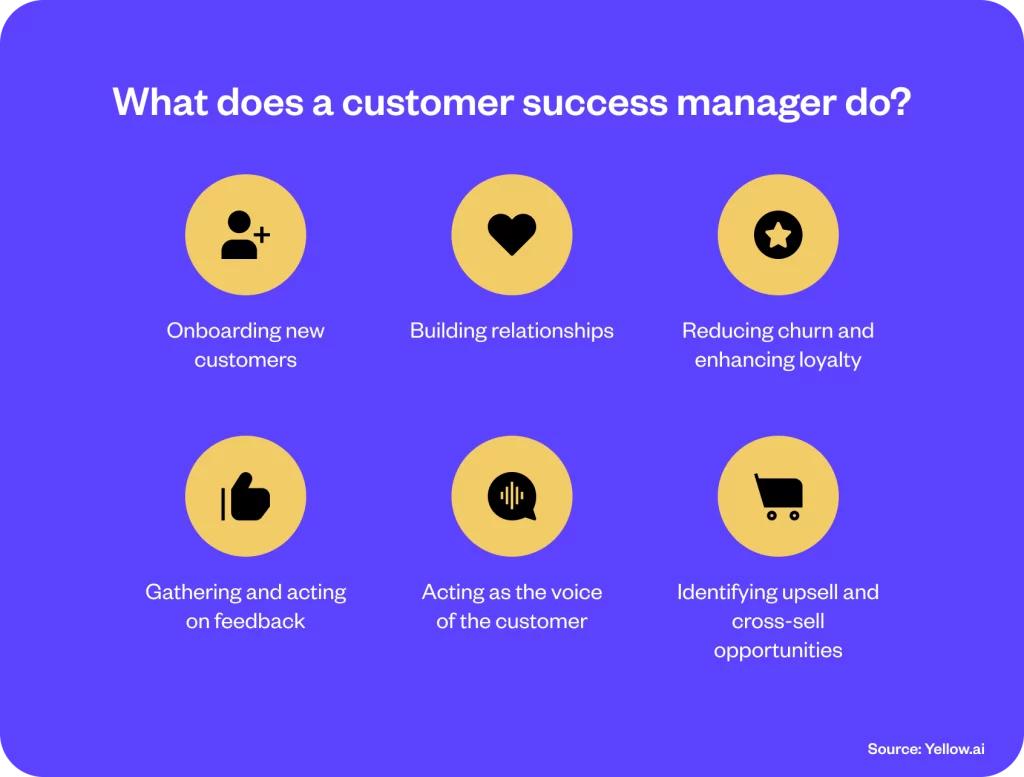
1. Onboarding new customers
The customer journey begins with onboarding, where CSMs ensure customers start on the right foot. Effective onboarding is crucial because it sets the tone for the customer’s entire journey. CSMs carefully guide new users through the product’s features and functionalities. The guidance is tailored to meet each customer’s specific goals. This proactive engagement helps customers quickly realize the value of their investment. It significantly reduces the risk of early churn.
2. Building relationships
CSMs excel in building strong, trust-based relationships with customers. They are the main point of contact for customers, as they provide a consistent and reassuring presence. By understanding customer goals and aligning them with the product’s capabilities, CSMs transform transactions into meaningful partnerships. These relationships are not merely beneficial for retaining customers but are pivotal in turning them into advocates for the brand.
3. Reducing churn and enhancing loyalty
A primary responsibility of a CSM is to mitigate churn by identifying at-risk customers and intervening before issues escalate. They monitor key metrics such as product usage patterns, customer satisfaction scores, and renewal rates to address concerns proactively. By keeping a pulse on the customer’s experience, CSMs can tailor strategies to enhance satisfaction and loyalty. It ensures customers stay and strengthen their relationship with the product.
4. Identifying upsell and cross-sell opportunities
CSMs play a key role in driving revenue growth through upselling and cross-selling. With their deep understanding of both the product and the customer’s business, they are ideally positioned to recommend additional features or products that complement the customer’s existing setup. These recommendations are strategic advice aimed at helping customers achieve tremendous success.
5. Gathering and acting on feedback
Feedback collection is an ongoing task for CSMs. It provides invaluable insights into customer needs, challenges, and perceptions. By systematically collecting and analyzing feedback, CSMs can advocate for product improvements that directly address customer pain points. This feedback loop improves the product and also shows customers that their opinions are valued and acted upon.
6. Acting as the voice of the customer
CSMs represent the customer within the organization. It ensures that the product and service offerings continue to meet evolving customer needs. They bridge the gap between customer expectations and the company’s offerings. The CSMs advocate for features, changes, or enhancements that enhance customer satisfaction and success.
Jim Bush, a Former Executive of American Express
“Getting service right is more than just a nice to do; it’s a must-do. American consumers are willing to spend more with companies that provide outstanding service, and they will also tell, on average, twice as many people about bad service than they will about good service. Ultimately, great service can drive sales and customer loyalty.”
Responsibilities of a customer success manager
The role of a Customer Success Manager is both art and science. It requires a balance of technical knowledge, empathetic communication, and strategic foresight. In their hands, customer success becomes a shared journey toward achieving lasting business impact and customer fulfillment. The key responsibilities of customer success managers are given below.
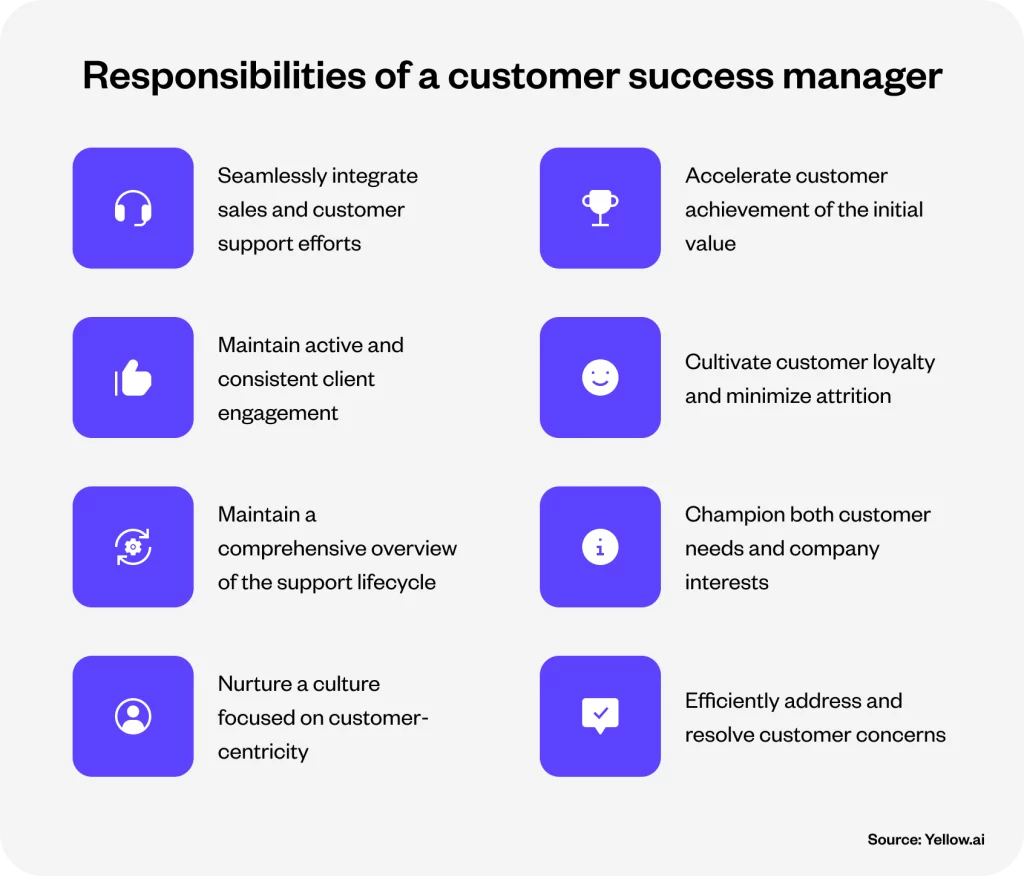
1. Seamlessly integrate sales and customer support efforts
A CSM acts as the critical link that seamlessly connects the promise of sales with the reality of ongoing support. By ensuring customers understand how to use their new products effectively from day one, CSMs play a direct role in setting the stage for long-term satisfaction.
For example, a CSM might guide a customer through the initial setup of a complex project management tool. It will ensure the customers understand not just the ‘how’ but the ‘why’ behind its features. This proactive approach can transform potential overwhelm into enthusiasm. Moreover, it can lay the groundwork for a fruitful relationship.
2. Accelerate customer achievement of the initial value
The journey from purchase to experiencing real value is pivotal. CSMs expedite this process by tailoring the onboarding experience to each customer’s specific objectives.
Consider a healthcare provider implementing new patient management software. A CSM could facilitate training sessions that highlight features most relevant to the provider’s daily operations, such as appointment scheduling and patient follow-ups. It can significantly speed up the time to value.
Sam Walton, Founder of Walmart and Sam’s Club:
“There is only one boss. The customer. And he can fire everybody in the company from the Chairman on down simply by spending his money somewhere else.”
3. Maintain active and consistent client engagement
Active engagement is vital. Through regular check-ins, CSMs ensure customers are not just using the product but are maximizing its potential. For instance, a CSM might notice a client isn’t utilizing a key feature that could streamline their workflow. By demonstrating this feature’s direct benefits, the CSM reinvigorates the client’s engagement with the product. It can enhance their operational efficiency.
4. Cultivate customer loyalty and minimize attrition
CSMs are at the heart of customer retention strategies, using their deep understanding of customer needs to nurture loyalty and preempt churn. By analyzing usage data, a CSM can identify a decrease in activity, prompting a timely intervention. A personalized check-in can uncover underlying issues, allowing for solutions that recommit the customer to the product and prevent them from seeking alternatives.
Colleen Barrett, Southwest Airlines, President Emeritus:
“To earn the respect (and eventually love) of your customers, you first have to respect those customers. That is why Golden Rule behavior is embraced by most of the winning companies.”
5. Maintain a comprehensive overview of the support lifecycle
With their overarching perspective, CSMs identify trends across individual customer experiences to improve the collective customer journey. Should a pattern of challenges with a specific feature emerge, the CSM can coordinate with the product team to refine it. It will enhance usability for all customers and solidify the product’s market position.
6. Champion both customer needs and company interests
CSMs are uniquely positioned to align customer feedback with the company’s strategic goals, advocating for changes that benefit both parties. For example, when multiple customers request a feature that aligns with the company’s growth direction, the CSM champions this feedback. It facilitates enhancements that drive customer satisfaction and product innovation.
7. Nurture a culture focused on customer-centricity
Through collaboration and advocacy, CSMs instill a customer-centric culture across teams. It ensures the customer’s voice is always heard. For instance, by sharing customer success stories and challenges at company meetings, CSMs remind every department of their role in delivering value. It encourages a unified approach to customer satisfaction.
8. Efficiently address and resolve customer concerns
CSMs are frontline problem-solvers, turning potential frustrations into opportunities for positive engagement and reaffirmation of the customer’s choice. For example, a timely resolution of a billing issue solves the immediate problem and also strengthens the customer’s trust in the company’s commitment to their success. It often leads to increased loyalty and word-of-mouth referrals.
Key metrics for customer success managers
Understanding the performance and impact of customer success managers (CSMs) is crucial for businesses aiming to cultivate enduring customer relationships and drive growth. To navigate this landscape, CSMs rely on a set of key metrics that act as their compass, guiding strategies to ensure customer satisfaction and business success. Let’s explore these metrics in detail, illustrating their importance and practical applications.
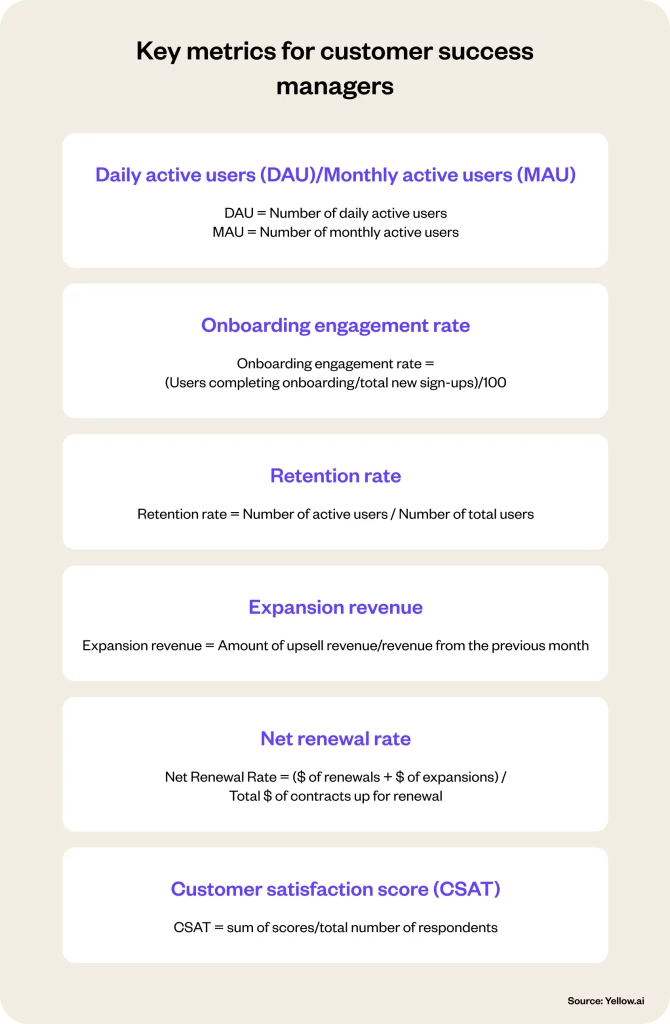
1. Daily active users (DAU)/Monthly active users (MAU)
DAU and MAU track the number of unique users engaging with your product daily or monthly, respectively. This metric is essential for understanding the regularity and depth of customer engagement with your product.
High DAU/MAU ratios indicate a product’s stickiness and user reliance. It reflects positively on customer satisfaction and product value. For instance, a SaaS company might observe a spike in DAU after releasing a much-requested feature, signaling increased user engagement and product fit.
Calculation method
DAU is the number of unique users who engage with your product within a 24-hour period, while MAU counts those within a calendar month. Here is the simple formula:
DAU = Number of daily active users
MAU = Number of monthly active users
Example: If a messaging app observes its DAU increasing from 10,000 to 15,000 after introducing video calling features, it indicates the feature’s success in boosting daily engagement.
2. Onboarding engagement rate
This metric evaluates how actively new users engage with your onboarding process. It provides insights into the effectiveness of your initial customer education efforts.
A high onboarding engagement rate is a precursor to customer success, as it indicates that customers are effectively learning to utilize your product to its fullest potential. For example, an e-commerce platform might track how many new merchants complete a setup wizard. It will directly correlate with their likelihood of making their first sale quickly.
Calculation method
Measure the percentage of new users who complete key onboarding steps out of the total number of new sign-ups. Here is the formula:
Onboarding engagement rate = (Users completing onboarding/total new sign-ups)/100
Example: An online project management tool implements a new interactive onboarding tutorial. If 800 out of 1,000 new sign-ups complete the tutorial, the onboarding engagement rate is 80%. This high engagement suggests that the tutorial is effective in guiding new users through the product’s features.
3. Retention rate
Retention rate measures the percentage of customers who continue to use your product over a specific period. It indicates customer satisfaction and product-market fit.
Retention is the backbone of sustainable business growth. High retention rates suggest that customers find lasting value in your product. For instance, a mobile app with a high retention rate indicates that users regularly return to the app. It affirms the app’s value in their daily routines.
Calculation method
Calculate the percentage of customers who continue to use your product over a specific time frame compared to the initial number. Follow this formula:
Retention rate = Number of active users / Number of total users
Example: A software company starts the quarter with 200 customers, gains 50 new customers, and loses 20. So, the total number of active users is 230. Hence, the retention rate is 92.5%, indicating strong customer loyalty.
4. Expansion revenue
Expansion revenue tracks the increase in revenue from existing customers through upsells, cross-sells, or service upgrades. It showcases customer satisfaction and loyalty.
Successful expansion strategies signify that customers see enough value in your offerings to invest more over time. For instance, a B2B software company might measure how many existing customers upgrade to a premium tier. It indicates satisfaction and deeper integration of the software into their operations.
Calculation method
Track the increase in revenue from existing customers due to upsells or cross-sells over a specific period. Use the following formula:
Expansion revenue = Amount of upsell revenue/revenue from the previous month
Example: If a cloud hosting service’s upsell initiatives generate an additional $5,000 on a base of $50,000, the expansion revenue is 10%. This growth indicates successful upsell strategies.
5. Net renewal rate
This metric calculates the percentage of revenue retained from existing customers after accounting for downgrades and churn. It provides a clear picture of customer loyalty and product satisfaction.
A net renewal rate of over 100% indicates that customers are staying and also that they’re expanding their investment in your product. It is a strong indicator of customer success. For instance, a cloud services provider could use this metric to assess the effectiveness of their account management strategies.
Calculation method
Calculate the ratio of revenue retained from existing customers, including upsells, compared to the potential renewal revenue at the start of the period. Use the following formula:
Net Renewal Rate = ($ of renewals + $ of expansions) / Total $ of contracts up for renewal
Example: A business software company with $100,000 in contracts up for renewal secures $110,000 in renewals and upsells, leading to a net renewal rate of 110%, showcasing customer retention and account growth.
6. Customer satisfaction score (CSAT)
CSAT gauges customers’ satisfaction with your product or service at specific touchpoints. It offers immediate feedback on their experience.
This direct feedback tool helps businesses quickly identify areas of success and opportunities for improvement. For example, a high CSAT score at a support interaction point indicates effective customer support, whereas a low score signals the need for review and action.
Calculation method
After interactions, customers rate their satisfaction on a scale (e.g., 1-5). Use the following formula then:
CSAT = sum of scores/total number of respondents
Example: After deploying a new support ticket system, a company surveys 200 customers, receiving an average score of 4.5 on a 5-point scale. The CSAT of 90% reflects high customer satisfaction with the support experience.
What makes a good customer success manager?
Identifying what makes a good customer success manager (CSM) is crucial for building lasting relationships with customers. A good CSM stands out by embodying certain core traits that make them invaluable. Here’s a concise breakdown of what sets a good CSM apart:
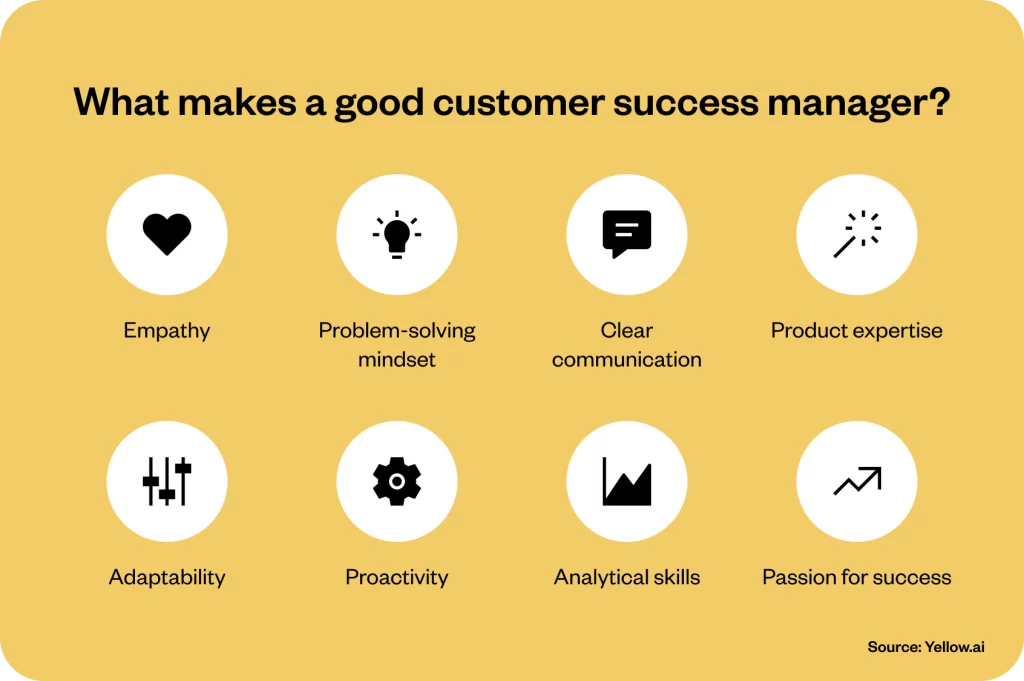
- Empathy: They truly understand customer’s perspectives and challenges, making clients feel seen and supported.
- Problem-solving mindset: Beyond fixing issues, they anticipate problems and offer proactive solutions.
- Clear communication: Whether it’s explaining product features or listening to concerns, they keep the lines of communication open and accessible.
- Product expertise: They know the product inside and out, guiding customers through any scenario with ease.
- Adaptability: Customer needs can change quickly; a good CSM is always ready to pivot the strategy to meet these evolving demands.
- Proactivity: They don’t wait for a signal to check in with customers, ensuring consistent engagement and satisfaction.
- Analytical skills: Understanding data is essential for tailoring the customer experience and predicting future needs.
- Passion for success: Above all, they genuinely want to see their customers succeed, driving them to go the extra mile.
Top customer success manager skills
The capabilities of a customer success manager (CSM) can truly make or break the customer experience. What sets a great CSM apart is not just what they do but how they do it. Let’s understand what makes a CSM excel in their role.
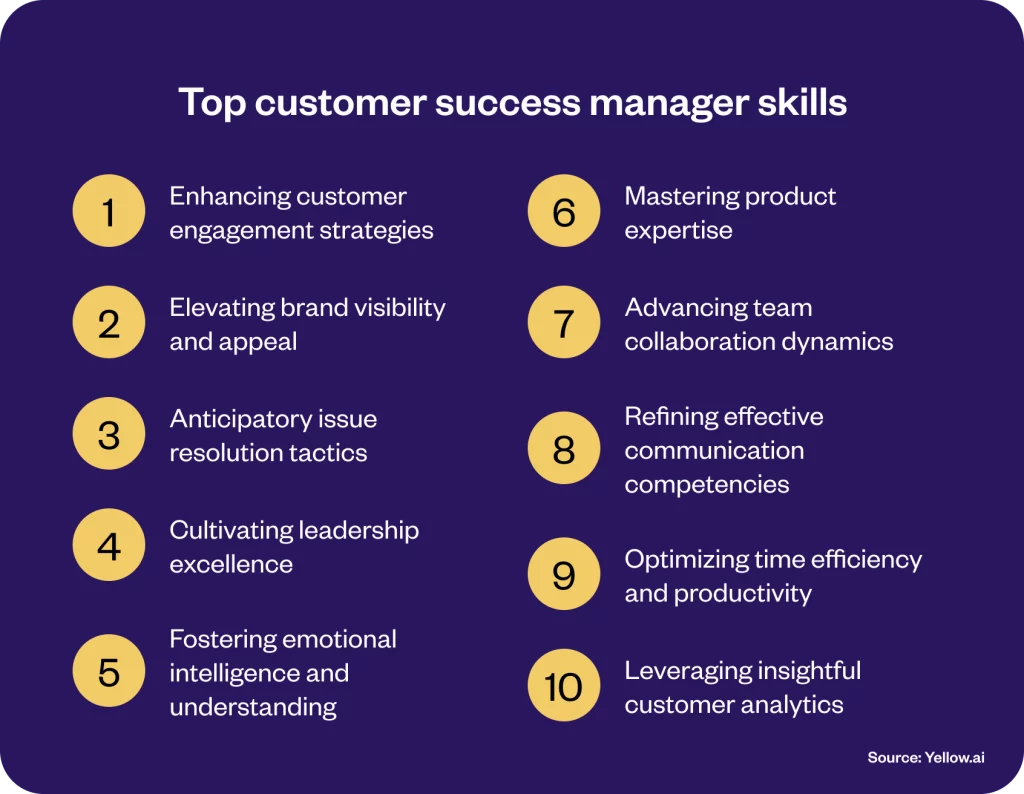
1. Enhancing customer engagement strategies
Customers often feel disconnected when their post-purchase experience doesn’t match the enthusiasm of the sales process.
Mastering the art of customer engagement involves crafting personalized, proactive outreach efforts that keep customers involved and informed. By regularly sharing valuable insights and updates, CSMs can transform passive users into active product advocates. Moreover, it develops a sense of community and loyalty.
Related read: 7 Proven strategies to improve customer engagement
Pro tip: Implement regular, value-driven communication schedules and leverage customer feedback to refine engagement tactics continually.
2. Elevating brand visibility and appeal
In an overcrowded market, customers might lose sight of a brand’s unique value proposition.
CSMs need the ability to clearly articulate and demonstrate the ongoing value their product or service offers. It will ensure the brand remains top of mind for customers. The skillful brand advocacy by CSMs reinforces the product’s relevance and also opens doors for upselling and cross-selling opportunities.
Pro tip: Develop compelling case studies and share success stories to highlight real-world applications and benefits.
3. Anticipatory issue resolution tactics
Customers become frustrated when they encounter repetitive issues or feel their feedback goes unheard.
Proactivity in identifying and addressing potential customer issues before they escalate is crucial. This preemptive approach minimizes dissatisfaction and churn and solidifies trust in the brand.
Pro tip: Utilize customer data analytics to predict and mitigate issues and establish a feedback loop for continuous improvement.
4. Cultivating leadership excellence
Teams lack direction in their customer success initiatives. It usually leads to inconsistent customer experiences.
Effective CSMs lead by example, providing clear guidance and fostering a culture of excellence within their teams. Strong leadership ensures a unified approach to customer success. As a result, it enhances the overall quality of service.
Pro tip: Engage in leadership training and mentorship programs to refine your leadership style and strategy.
5. Fostering emotional intelligence and understanding
Miscommunications and unmet expectations can sour customer relationships.
A high degree of emotional intelligence allows CSMs to empathize with customers, accurately gauge their sentiments, and adjust their approach accordingly. This skill is critical for building deep, meaningful relationships that withstand challenges.
Pro tip: Practice active listening and empathy in every customer interaction, and seek feedback to improve your understanding.
6. Mastering product expertise
Customers lose confidence in a product when they sense hesitancy or lack of knowledge from their CSM.
In-depth product knowledge enables CSMs to address queries confidently, offer insights, and guide customers through complex scenarios. This expertise resolves customer issues efficiently and also educates and empowers users to get the most out of their purchases.
Pro tip: Regularly participate in product training sessions and stay updated on new features and updates.
7. Advancing team collaboration dynamics
Siloed departments can lead to disjointed customer experiences and overlooked opportunities for improvement.
CSMs must excel in cross-functional collaboration, bringing together various departments to align on customer success goals. Effective collaboration ensures a cohesive strategy that leverages collective insights for better service delivery.
Pro tip: Build open communication channels and regular cross-departmental meetings to discuss customer insights and strategies.
8. Refining effective communication competencies
Complex jargon or unclear messaging can confuse customers, leading to frustration.
Clear, concise, and compelling communication (both verbal and written) is essential for explaining product features, addressing concerns, and conveying value. This clarity improves customer comprehension and satisfaction. As a result, it reduces confusion and misinterpretation.
Pro tip: Practice simplifying complex concepts into easily digestible information and tailor your messaging to the audience’s level of expertise.
9. Optimizing time efficiency and productivity
Time constraints and competing priorities can hinder a CSM’s ability to provide personalized attention to each customer.
Exceptional time management and prioritization skills allow CSMs to efficiently balance customer needs with internal tasks. This efficiency ensures all customers receive timely and effective support. Moreover, it maximizes satisfaction and retention.
Pro tip: Utilize productivity tools and techniques to streamline tasks and automate routine processes where possible.
10. Leveraging insightful customer analytics
Without data-driven insights, CSMs may miss trends in customer behavior or areas for improvement.
The ability to interpret and act on customer data analytics enables CSMs to make informed decisions and personalize customer strategies. This analytical approach identifies opportunities for enhancement, aligns services with customer needs, and drives strategic growth.
Pro tip: Regularly review customer usage data, feedback, and support tickets to identify patterns and actionable insights.
How Yellow.ai can elevate your customer success strategy?
The synergy between technology and customer success becomes undeniable in today’s digital-first world. The Yellow.ai platform is leading the way, as that is where artificial intelligence collides with human empathy. It revolutionizes how businesses interact with their customers. That is where customer success managers (CSMs) find their secret weapon, enabling them to offer timely, intuitive, and personalized support.
1. AI-powered chatbots for 24/7 support: Yellow.ai’s chatbots leverage Natural Language Processing (NLP) to understand and respond to customer queries in real time. It ensures that assistance is available around the clock. This continuous support system elevates customer satisfaction and allows CSMs to focus on strategic initiatives rather than being bogged down by routine inquiries.
2. No-code chatbot builders: With Yellow.ai’s intuitive no-code platform, businesses can quickly design, build, and deploy custom chatbots tailored to their specific needs. This flexibility ensures that customer interactions are efficient and personalized.
3. Multilingual support: Yellow.ai’s chatbots can communicate in over 135 languages and dialects. It breaks down linguistic barriers and allows businesses to cater to a global audience. This multilingual capability ensures that all customers feel understood and valued, regardless of their native language.
4. Low latency performance (LLP): Yellow.ai’s platform is designed for high-speed response times. It ensures that customer queries are addressed promptly. This quick turnaround is crucial for maintaining customer satisfaction and fostering a positive perception of the brand.
5. Advanced analytics and insights: Beyond interaction, Yellow.ai provides detailed analytics on performance and customer engagement patterns. These insights enable CSMs to make data-driven decisions to continually refine their customer success strategies and identify areas for improvement.
Ready to transform your customer success operations with AI-driven efficiency and personalization? Book a demo with Yellow.ai today and discover the future of customer engagement.
The final thoughts
In a world that’s constantly changing, one thing remains constant: the importance of the customer. As we look to the future, it’s clear that technology like Yellow.ai will play a pivotal role in shaping how businesses interact with their customers. It is making experiences extraordinary.
This future is not just about leveraging technology; it’s about creating a seamless mix of efficiency and empathy. It is about understanding that behind every ticket, query, or feedback form is a human seeking support, guidance, and understanding. And it’s right here, at this intersection of technology and human insight, that true customer success lies.
Frequently asked questions (FAQs)
What is the role of the Customer Success Manager (CSM)?
The role of a Customer Success Manager (CSM) extends beyond traditional customer service. A CSM proactively works with customers to ensure they derive maximum value from a product or service, thereby enhancing satisfaction, fostering loyalty, and encouraging growth. It involves understanding customer goals, providing tailored support, and strategically guiding customers through their journey to achieve success.
What is the difference between customer support and customer success?
Customer support typically focuses on addressing specific issues or queries customers may have post-purchase. In contrast, customer success is a proactive and holistic approach aimed at ensuring customers achieve their desired outcomes with a product or service. While support reacts to immediate needs, success anticipates and strategizes for long-term customer satisfaction and growth.
Is customer success the future?
Absolutely. Customer success is becoming increasingly crucial in today’s competitive market environment. As businesses recognize the value of building lasting relationships and ensuring customer satisfaction, the focus on customer success strategies is intensifying. Besides driving retention and reducing churn, it also fuels expansion and advocacy. That makes it a vital component of future business success.
Why is customer success so in demand?
Customer success is in demand because it directly impacts a company’s bottom line by ensuring customers realize the total value of their purchase. It leads to higher retention rates, increased opportunities for upselling and cross-selling, and a more substantial brand reputation through customer advocacy. As businesses strive for sustainable growth, the strategic importance of customer success continues to rise. That makes it a sought-after function in the modern business landscape.


























